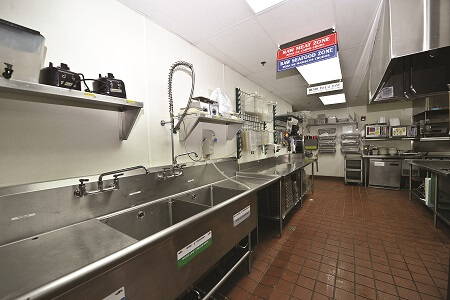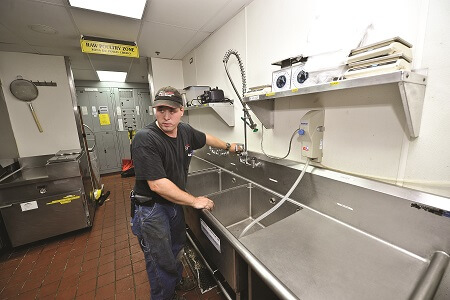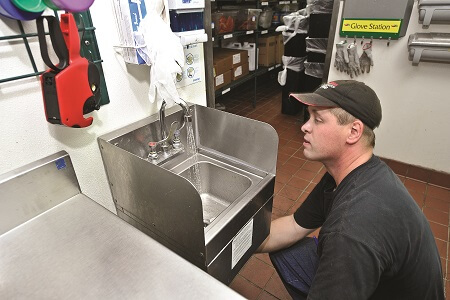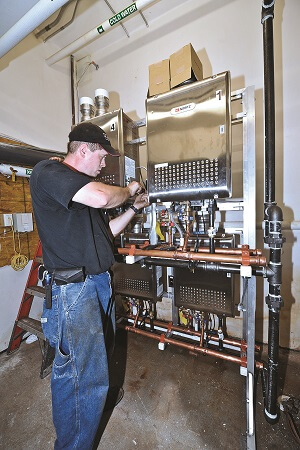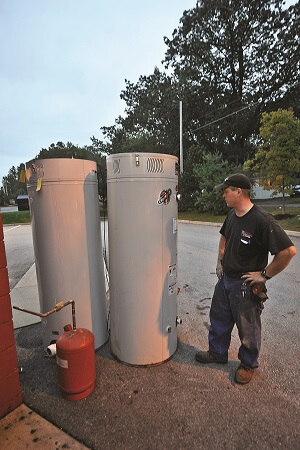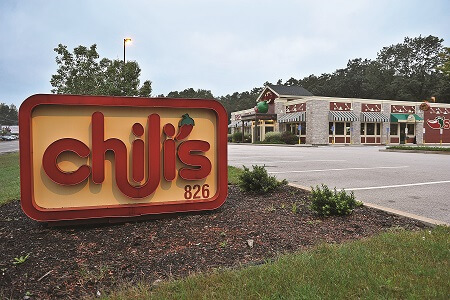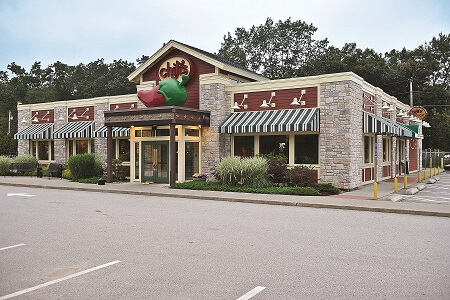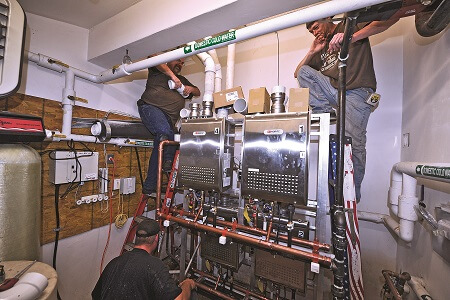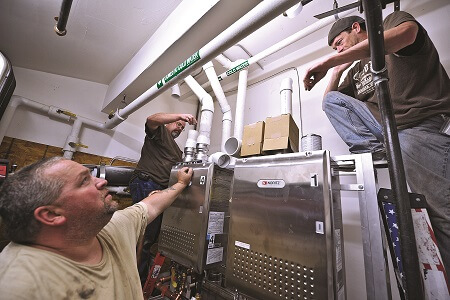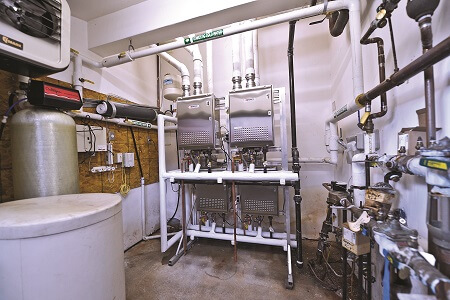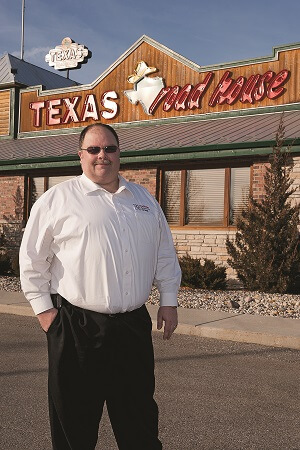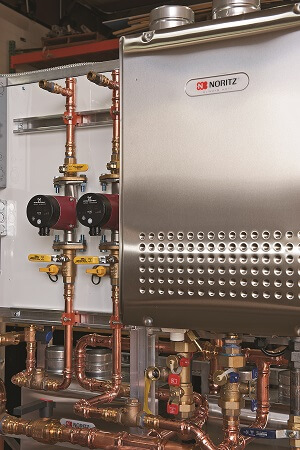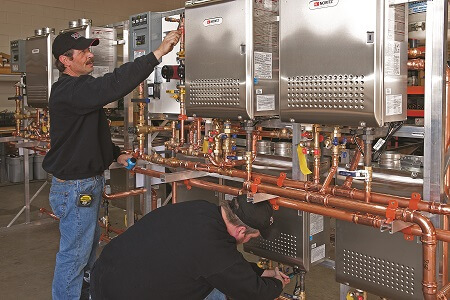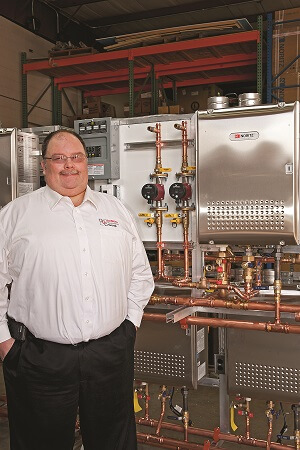Commercial Service Specialist Uses Multi-Unit Tankless Water Heating Systems to Solve Restaurants’ Hot-Water Problems
Facilities Resource Group offers turnkey Noritz tankless water heating packages, prefabricating rack systems at its Michigan headquarters, shipping and installing them at restaurants nationwide with the help of local plumbing contractors.
Property Profile |
|
|---|---|
| Location | Facility Resource Group |
| City | Grandville, Michigan |
GRANDVILLE, MICH. — Hot water is the lifeblood of any restaurant kitchen operation. Lacking a sufficient and ready supply at the correct temperatures, as prescribed by local health authorities, facility management usually has no choice but to lock the doors until the problem is fixed.
But despite the vital importance of hot water, getting the right quantities to right outlets at the right temperatures – especially during operational peaks – is an anxious, uphill battle for many managers. Whether the culprit is undersized equipment, poor installation or inadequate maintenance, many restaurants routinely endure a tense, can’t-live-with-‘em/can’t-live-without-‘em relationship with their commercial water heaters.
But a relatively new and innovative approach to restaurant water heating that melds all of the necessary components into a single, prefabricated, ready-to-install package is achieving positive results for a growing number of proprietors, who have experienced improved system performance and longevity as well as energy savings.
Chilli's Resaurant - West Auburn, Massachusetts
Developed by Facilities Resource Group (FRG) of Grandville, Mich., the innovation is an engineered rack system that combines one to six tankless water heaters from Noritz America with isolation valves, system and pump controllers, surge protectors, and even recirculation pumps and expansion tanks as needed – all mounted to a mobile aluminum frame and finished off with insulated copper tubing.
This type of multi-unit apparatus, of course, can be seen in numerous commercial installations around the country. The true breakthrough by FRG was its decision to leverage the inherent advantages of multiple tankless water heaters into a turnkey service program that caters specifically to the rigorous demands of fast-food and casual-dining restaurant chains. Instead of the manufacturer shipping one or more tankless units to a job site – either directly or through a local supplier – for installation by a local contractor, FRG takes direct control of the transaction by:
- designing and fabricating the water heater racks in its western Michigan facility;
- shipping them in FRG trucks to wherever the restaurant is located nationwide;
- personally participating in the installation of the rack with a qualified local contractor, usually after work hours, so that the restaurant suffers no down time;
- coordinating post-installation service work, either with the installer or another service company that has participated in a Noritz commercial tankless training program.
The rationale for this turnkey package is based, again, on the key role hot water plays in a restaurant’s daily operation and the impact it can have on its long-term viability.
“I have seen restaurant chains spend thousands of dollars to ship cooking equipment cross-country overnight just to prevent any loss of business on an upcoming busy day,” says FRG director of mechanical sales and engineering Benjamin C. Wirick. “These operators are concerned about not just the lost dollars and cents they can count, but also the less-tangible losses. If they must shut down for even half a day, will disappointed customers opt for a restaurant down the street and never come back? They don’t want to take that chance.”
Different Kind of Company
Since launching its comprehensive service in 2008, FRG has designed, built and installed approximately 800 tankless water heater rack systems in 200 corporate and franchised restaurant locations nationwide. The company’s most prominent accounts include Texas Roadhouse Corporation (35 new-facility installations and 160 retrofits) and Pepper Dining Inc. (PDI), which owns and operates 106 Chili’s facilities in 10 Northeastern states (38 retrofits).
As you may have already guessed, FRG is not a conventional mechanical or plumbing contractor, nor a consulting and specifying engineer. Established in 1999 by two veteran sales professionals from W.W. Grainger, John N. Weeber and James C. Faber, FRG describes itself as a “comprehensive facilities services company” that partners with large corporate customers by providing a wide array of products and services for design, installation, operations and service with “single-point responsibility.”
The latter, “responsibility” attribute is a key consideration for corporate managers like Scott Amerault, Director of Facilities at PDI. Before turning to FRG in February 2010, Amerault was personally and individually responsible for keeping the hot water flowing at all 100+ PDI facilities. “With other tankless suppliers, I handled everything,” he says, “from finding the product and hiring the installer to coordinating the installation with our local restaurant team.”
He also had the unenviable task of summoning the installer back to the restaurant when the retrofit failed to perform satisfactorily. “In some cases, it was just a nightmare of chasing people down and dealing with a lot of finger-pointing.
“Today, with FRG, I make one phone call, and they go to work with my local team to solve our problems. They understand our sense of urgency and are sensitive to our needs.”
The bottom-line payoff for PDI? “Working with FRG, I have never needed to close a restaurant equipped with a tankless water heater. In addition, I’ve never lost a single meal period on a proactive water heater replacement they’ve handled for me. Having worked in facilities management for 20 years, I cannot say enough about FRG’s service.”
Facilities Resource Group - Granville, Michigan
How FRG Does It
It’s not unusual for Wirick’s team to begin a project by viewing everyday, digital photographs of the mechanical room provided by the local restaurant. ”Most store managers have a smart phone,” he explains. “If I can’t get an FRG professional on-site to inspect the space because the timeframe is too tight, I’ll request a dozen or so photos to give us a better handle on how our rack will fit into the room.”
Wirick estimates that prefabricating a four-tankless heater rack — the most common configuration — takes an average of 32 hours, down roughly 20% from the 40-hour average of four years ago. Regardless of the number of units needed, FRG uses only the Noritz NCC199-DV, a condensing tankless model with an Energy Factor of 0.93. “The restaurant industry demands a return on its investment, so it has switched to higher-efficiency water heaters,” says Wirick, explaining why he opted for condensing technology. “That consideration counts as much as space savings to these corporations.”
The water heaters are pre-wired and pre-plumbed on manifolds and then mounted onto the aluminum frames along with the supporting components and accessories. Pumps and expansion tanks are also included on a rack for a new facility, but not on a retrofit, because these items are usually present in the existing plumbing system.
Once assembled, the rack is fitted with wheels and rolled onto one of two trailers, a 24-footer and a 38-footer, that FRG uses to travel to jobs across the nation. PVC piping, copper tubing, black iron for gas distribution along with other valves, fittings and materials are on board as well – and usually for more than one project; sometimes up to four. The driver? That would be the very same project manager who built the racks and who will now personally oversee their installation at the various restaurants, spending two or three weeks on the road at a time.
“Having the project managers do both the prefab and the installations short-circuits the blame game if something goes wrong on the job,” explains Wirick, who says these six individuals rotate between field and factory, with two or three traveling to installation sites, while the others are busy doing prefab work in Michigan.
“All of our project managers are licensed plumbers, so they know how to modify a system when the mechanical room proves more of a technical challenge than we anticipated,” says Wirick, who estimates that roughly one in five jobs, because of mechanical-room dimensions, involves disassembling the prefabbed racks and mounting the tankless units to the wall.
Success Factors
There are three major factors underpinning the success of the FRG program to date, and this trio can be summarized in three words: tankless, turnaround and turnkey.
Factor No. 1 – Tankless Water Heating: Before 2008, FRG had been supplying high-efficiency, storage tank-type water heaters to its fast-food and casual-dining restaurant clientele. At that point, most customers were still inclined to stick with traditional tank technology – the devil they knew – even if they found themselves without hot water and in need of new units with depressing frequency.
For these reasons, FRG believed the demand for a better way was just a matter of time, and so the company continued to search for a solution. The latest economic downturn helped refocus the customer’s attention on the problem.
“Restaurants put a heavy load on water-heating equipment, especially when they’re super-busy,” explains Wirick. In addition, the drive to maximize sales per square foot can result in a mechanical room that is simply too small to house the amount of hot-water storage the restaurant needs during its busiest times.
Which explains the advantage of going tankless, which de-emphasizes gallons of storage in favor of BTU inputs. “Without the need for storage, we can pack a lot more BTUs into the same small footprint,” Wirick says. “This enables the restaurant to manage its peak loads more easily at a lower operating cost.”
Meanwhile, that total BTU capacity is typically split among four, five or six water heaters, which delivers two more important advantages: load-matching to cut energy costs and, even more important, the peace of mind that comes from unit redundancy.
The ability to gear energy consumption to present demand delivers substantial savings and efficiency. The NCC199 units have an input range of 11,000 to 199,900 BTU per hour. If a single hand-sink faucet is turned on, only one of the assembled tankless units in an FRG rack will activate. The modulating burner inside the unit will fire at the lower end of the BTU input range to meet the isolated need: Why use 199,990 BTU when 11,000 will do?
“But a conventional commercial water heater whose burner does not modulate will immediately ramp up to its full BTU capacity to deliver hot water to that one hand sink,” says Wirick. “This not only wastes energy, but also stresses the equipment.”
The 35 Chili’s restaurants in PDI’s territory that have gone tankless all use an FRG rack or wall-hung system with four units. Amerault conducted an informal survey of the very first installation in June 2010 and determined he was saving roughly $1,800 per year. “But I haven’t done a formal, detailed energy analysis, because efficiency is not the driving force behind my company’s decision to go tankless,” he says. “We are even more enthusiastic about the reliability gained through multiple redundancies.”
As recently as early 2010, Amerault was closing down “what seemed like one restaurant weekly because of problems with the tank water heaters,” he recalls, adding that this was the case even when the restaurant used two tank units. “More often that not, the store still couldn’t get enough hot water. Maybe both units were down because the manager hadn’t noticed he was using the backup unit after the main one failed months ago.”
With four tankless water heaters, if one shuts down, Amerault’s operation still has nearly 600,000 BTU (199,900 x 3 units) at its disposal. Plus, fixing or replacing the down unit is also less expensive. “If a tank-type heater fails on a Friday night, I’m hiring a plumber to work at double time to replace that tank immediately. Depending on its size, it could take two or even three guys to do that work. But if I lose a tankless heater on a Friday night, I just operate with the other three. I can wait until Monday for service, and it’s only one guy carrying a new unit in on his shoulder and working straight time for 90 minutes.”
Factor No. 2 – Overnight Turnaround: Wirick realized early on that his program had no chance of succeeding — that is, of solving his customers’ chronic hot-water problems — if he took the conventional route to installation: directing shipments to the restaurant for a local plumber to install. Up to 70 percent of his prefab business is retrofit: replacing tank-type water heaters with multiple tankless configurations, he says.
“The ability to perform that conversion on-premises within a timeframe that will not disrupt operations, let alone close the facility, is all but impossible. We concluded that, to get the hot running again as fast as possible, we needed to do as much of the install as we could prior to arriving at the site.” Prefabrication at the factory became FRG’s solution.
Rick Frazine, a project manager at FRG since November 2010, recently completed a retrofit conversion at one of Amerault’s restaurants in West Auburn, Mass., that was representative of the three to five installations he oversees monthly. Work immediately commenced after the Chili’s facility closed at 11:00 p.m. and all the dishwashing was completed. Frazine, a licensed master plumber since 2002, and two employees of a local plumbing contractor turned off the hot water to the dishwasher and the various kitchen and restroom sinks. They then quickly pulled the two existing, 100-gallon tank units at the end of their service lives (only three years old), while removing whatever piping was no longer needed.
Frazine’s team then rolled a four-unit rack system, completed the previous week in Grandville, into the mechanical room, and the three men began piping it into place. As usual, the quarters were cramped, but at roughly seven-foot square, the space still accommodated the rack, two ladders and three men climbing all over it to make the necessary connections and insulate all the copper.
In addition to setting the rack, the team installed a new circulator and expansion tank in the system’s 140°F recirculation loop, as well as a mini-mixer beneath each of the 10 hand sinks to temper the water to 110°F to comply with the local code. A “maintenance monitor” pad in the manager’s office provides on-off control and tracks system water temperatures, while a flashing light indicates a maintenance issue.
All this work, including a final inspection, was done by 7:00 o’clock the next morning – several hours before the Chili’s staff returned to prepare for the lunch crowd. Frazine returned to the restaurant again that evening to run another performance test on the rack, double-check all the temperatures at the outlets, and tidy up the mechanical room until 3:00 a.m. After a few hours of sleep at his motel, he was back behind the wheel and headed to his next project.
“In the vast majority of installations – even when complications force us to hang the units on the wall – we have the hot water running close to opening time the next morning,” says Frazine. “When we cannot get the hot water back on, we will at least make sure there’s cold water for cooking and some cleaning. And we stay in close contact with the manager at all times, so he knows the status.”
Factor No. 3 – Turnkey Plus: Obviously, turnkey and turnaround go hand-in-hand for FRG clients. But when Amerault says “turnkey,” he is thinking not only of the fully assembled rack, but also of that second trip Frazine made to his West Auburn facility. “When FRG does a conversion, they not only install the water heaters, but they also check every usage point for hot water in the building, making sure my dishwasher and every faucet is running at an optimum level,” he says. “They really take ownership of the entire hot-water system.”
“Every one of these restaurants is a system with the water heating equipment as its heart,” explains Wirick. “If the vessels and other components – the veins, if you will – are not properly connected to one another and to the heart, the restaurant simply won’t function.” That breakdown and dysfunction are what so often creates problems for water heater manufacturers, according to Wirick, and their equipment winds up being blamed for what is a systemic problem.
This is why FRG emphasizes follow-up technical support as much as it does prefabrication and installation, positioning itself as the single, ongoing point of contact for the customer when it comes to servicing an “FRG-certified System.” The company maintains electronic records on all service calls by local technicians it recruits, and it doesn’t hesitate to note when a restaurant staff has neglected proper procedures, such as putting salt into the water conditioner. In doing so, FRG is effectively “our manufacturer-partner’s best friend by representing them as well as the restaurant on site,” says Wirick.
“Restaurant managers are ‘laser-trained’ to use certain procedures on a consistent basis to minimize operational costs and maximize profits,” he continues. “We bring the same dedication to consistency in our work, applying good practices we develop in one restaurant or region across the United States.
“We are the eyes and ears of our customers, and we own their water-heating system from cradle to grave. We’re confident enough to say that any restaurant operator who has seen the FRG approach to installing and servicing water heaters will never go back to their old ways again.”
For editorial assistance, contact:
John O’Reilly
GreenHouse Digital + PR
T – 815.469.9100, ext. 302
E-mail – john@greenhousedigitalpr.com
# # #
NORITZ AMERICA CORPORATION, a subsidiary of Noritz Japan, has corporate offices in Fountain Valley, Calif., as well as in Dallas, Atlanta, Chicago and Hawthorne, N.Y. Offering a full line of tankless water heaters to meet the hot water demands of residential and commercial applications. Noritz supports its products with a national network of skilled representatives and employees who are committed to providing the finest products and services to our communities by helping consumers live in a more comfortable, efficient and healthy lifestyle.
For more information on Noritz America and the entire line of Noritz’s ENERGY STAR® tankless water heaters, please call (877) 986-6748 or visit our website at www.noritz.com.

